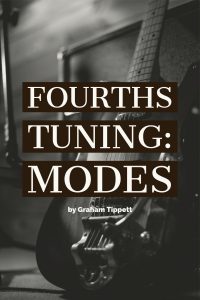
In Fourths Tuning Modes, we discover a beautiful symmetry about modes in fourths tuning (E, A, D, G, C, F or any variation thereof) that’s well-worth exploring, which is why I’ve dedicated an entire book to it. With that B-string bump out of the way, we’re free to explore modes both as scales in their own right and as parent scales belonging to a key. There’s just something about fourths tuning that makes the transition from theory to practice, and then mastery, a fairly effortless one; and this is what I want you to experience.
In Fourths Tuning Modes, our objective will be to follow this process in order to incorporate the modes of the major scale and the melodic minor scale into our playing. What I’ll provide you with is a concise and effective explanation of the theory behind modes (should you need it), then a system to put this knowledge into practice on the fourths fretboard without learning endless scale patterns or drilling rote patterns.
We’ll do this both for parent scales (modes applied to diatonic chord progressions) and modes as scales in their own right (modes for improvising over isolated chords or non-diatonic progressions in fusion styles). What’s more, if you’re making the transition from standard tuning to fourths tuning, this book will help you organize modes on the fourths fretboard and fill in any gray areas you may have had in standard tuning.
We’ll also learn how to instantly find the parent scale of any mode, how to come up with modal chord progressions, how to properly use backing tracks, as well as clearing up all the doubts that arise when learning modes for the first time.